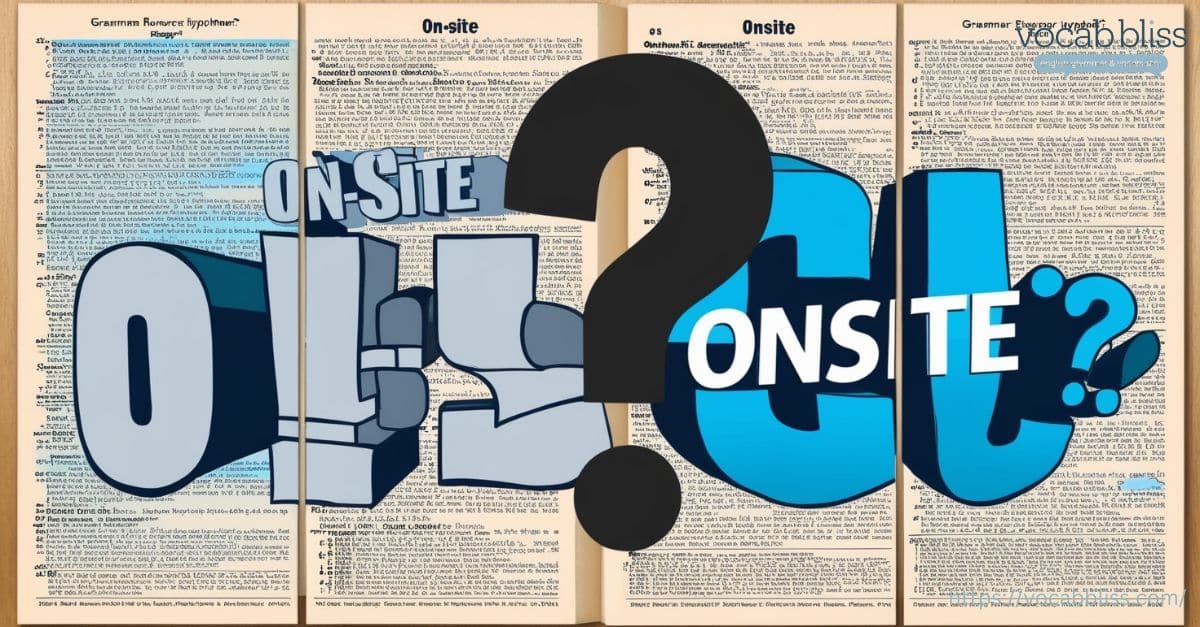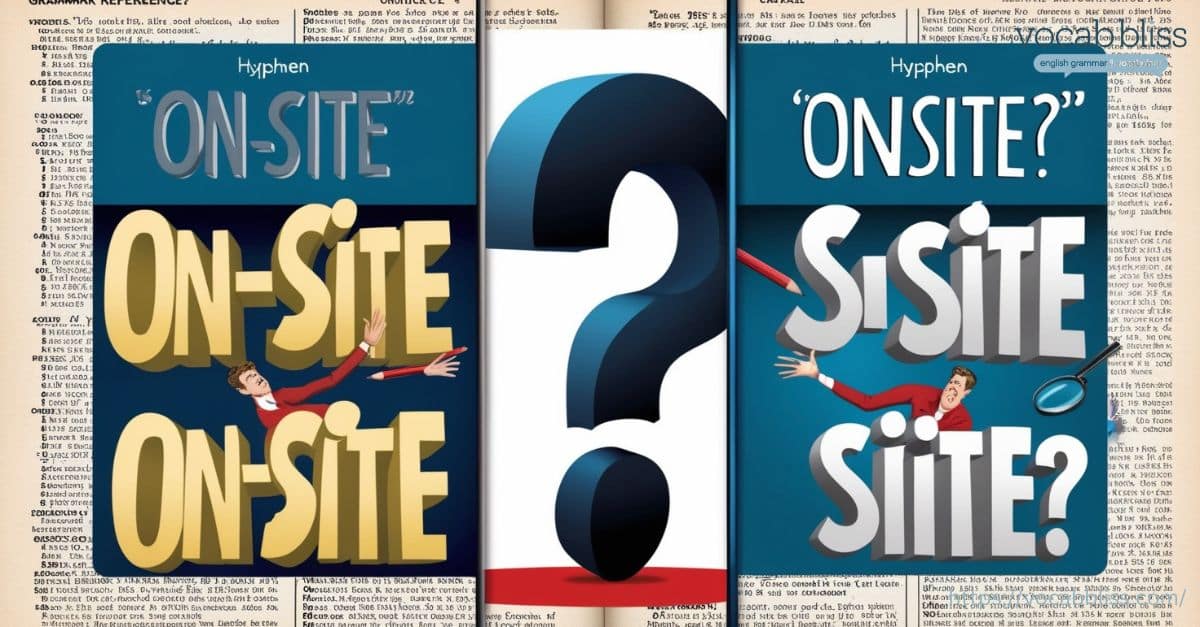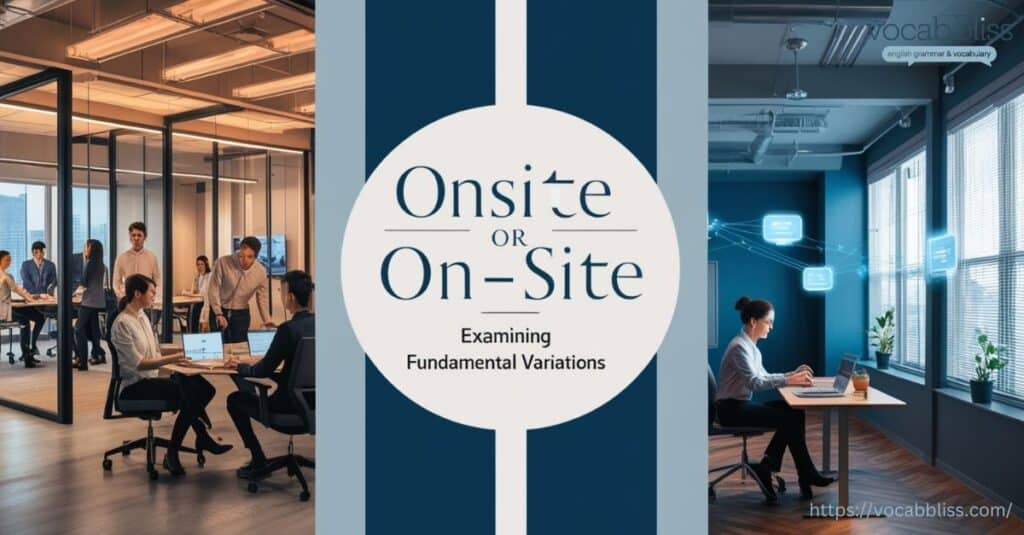Effective communication depends on clarity, especially when choosing between similar terms like onsite or on-site. Whether you’re writing an email, drafting a proposal, or composing website content, knowing the distinctions between these two forms is crucial for professional and everyday contexts.
In this comprehensive guide, we’ll thoroughly explore the keyword differences between “onsite” and “on-site.” Furthermore, along the way, you’ll find detailed definitions, clear usage examples, essential style guide recommendations, and practical advice to help you master these terms effectively.
Quick Summary
Choosing between on-site vs onsite often depends on the context, formality, and writing style. While both refer to activities or services performed at a specific location, their usage differs slightly. Onsite, written as a single word, is commonly used in informal communication and modern industries like IT and event management. On the other hand, on-site, with a hyphen, is preferred in formal writing, legal documents, and technical contexts where clarity is crucial. For example, “onsite support” might appear in an email, whereas “on-site inspection” is standard in a professional report. Understanding these subtle differences ensures your writing is accurate, context-appropriate, and professional.
Understanding the Terms: Onsite vs On-Site

To choose between on site vs onsite, it’s essential to understand their definitions, usage, and nuances. Both terms relate to a location, but their application varies depending on formality and clarity requirements.
Discover more: Batton or Baton: Which One Is Right?
What Does “Onsite” Mean?
Onsite is a single word that primarily functions as an adjective, specifically describing services, activities, or events occurring at a specific location. Moreover, it’s widely used in less formal communication and particularly within specific industries where brevity and modern language conventions are highly valued.
Definition:
- Onsite: Refers to activities or services performed at the location in question, often implying proximity or accessibility.
Examples of Industries and Scenarios Where “Onsite” is Common:
- IT Support:
- “We provide onsite technical assistance for server installations and maintenance.”
- Why? IT often demands immediate, location-based problem-solving, making “onsite” a frequently used term.
- Event Management:
- “Our team offers onsite coordination to ensure smooth event execution.”
- Why? Event managers need to highlight their presence at the event location to reassure clients.
- Education and Training:
- “The company delivers onsite training programs tailored to team needs.”
- Why? This emphasizes hands-on learning at the organization’s physical space.
- Construction and Real Estate:
- “All engineers must remain onsite during inspections.”
- Why? Presence on the construction site ensures immediate issue resolution.
When to Use “Onsite vs On-Site”:
- Informal Writing: Emails, casual business communication, or marketing materials.
- Example: “Our onsite gym is available 24/7 for employees.”
- Industry-Specific Jargon: Certain fields like IT and construction commonly prefer “onsite” for brevity.
- Modern Writing: As language evolves, “onsite” has become acceptable in various professional settings, particularly in tech-related industries.
While onsite works well in less formal situations, care must be taken in formal or traditional contexts where clarity might be better served with on-site.
Is “Onsite” Hyphenated?

Historically, “onsite” was hyphenated as “on-site.” Over time, language evolution and modern writing styles have led to the unhyphenated version becoming acceptable, particularly in informal or industry-specific contexts.
What Do Style Guides Say?
- Associated Press (AP) Style: Prefers hyphenation (on-site) for clarity.
- Chicago Manual of Style (CMS): More flexible, allowing “onsite” for informal contexts.
- Merriam-Webster Dictionary: Lists “onsite” as a valid form without the hyphen.
Onsite One Word or Two?
In formal writing, “onsite” is often treated as one word. However, for added clarity, some writers use “on site” as two separate words when referring to a physical location.
Examples of “On Site”:
- “The contractor is working on site today.”
- “Inspectors visited the site to ensure safety compliance.”
What Does “On-Site” Mean?
On-site is the traditional, hyphenated form of the term and is typically used in formal contexts or when clarity is a priority. It also functions as an adjective, describing services, activities, or events occurring at a specific location. The hyphen helps to clearly link the words “on” and “site,” avoiding potential ambiguity in sentences.
Definition:
- On-site: Describes tasks, services, or events happening at a designated physical location.
Examples Where “On-Site” is Required for Clarity or Correctness:
- Formal Writing:
- “The project manager conducted an on-site inspection to ensure compliance.”
- Why? In reports, proposals, or academic contexts, the hyphen adds professionalism and eliminates confusion.
- Avoiding Ambiguity:
- “The company scheduled an on-site meeting with the client.”
- The phrase could mislead readers into interpreting it as two separate ideas: “on” and “site meeting,” without the hyphen.
- “The company scheduled an on-site meeting with the client.”
- Legal or Technical Documents:
- “All employees must attend an on-site safety training session.”
- Why? Contracts or regulations demand precision, where the hyphen clearly connects the modifier and noun.
- Creative Writing or Journalism:
- “The journalist reported live from the on-site disaster relief center.”
- Why? Hyphenation ensures readability in contexts where quick understanding is essential.
- When Adjectives Follow the Noun:
- “The facility is equipped for services conducted on site.”
- Why? Without the hyphen, “on site” remains two separate words when used as an adverbial phrase.
When to Use “On-Site”:

- Professional and Academic Writing: The hyphen signals formality and precision.
- Clarity-Driven Contexts: Use “on-site” when there’s a risk of misinterpretation.
- Following Style Guides: Publications like AP and MLA often mandate the hyphen.
In summary, on-site excels in formal and technical writing, where clarity and professionalism are crucial. Using the hyphen demonstrates attention to detail and ensures seamless communication.
Side-by-Side Comparison onsite or on-site
| Feature | Onsite | On-Site |
|---|---|---|
| Definition | Adjective for location-based activities or services | Same, but with a hyphen for clarity and formality |
| Part of Speech | Adjective | Adjective |
| Common Contexts | Informal, industry-specific | Formal, academic, or legal |
| Style Guide Preference | More accepted in modern usage | Preferred in formal writing |
| Examples | “Onsite support is available.” | “On-site inspections are mandatory.” |
Everyday Usage Examples
Here are scenarios showing how to use these terms effectively:
- Business Communication:
- “Our team provides onsite support for enterprise clients.”
- “All on-site services adhere to strict quality standards.”
- Educational Settings:
- “Students can access onsite tutoring for extra help.”
- “The college hosted an on-site workshop on career development.”
- Event Management:
- “The wedding planner offered onsite coordination for the big day.”
- “The venue includes on-site catering options for events.”
When to Use Which: Style Guide Insights

Choosing between ‘on site or onsite‘ often depends on your audience, writing context, and adherence to specific style guides. Major style authorities prefer one form over the other, so understanding their preferences can help you decide when to use each.
- Formal Writing: Use on-site for clarity and professionalism.
- Informal Writing: Onsite is acceptable, especially for modern, casual communication.
- Consistency: If you start using “on-site” in a document, stick to it throughout for uniformity.
Style Guide Recommendations:
- AP Style: Always use on-site.
- The Chicago Manual of Style accepts either form but prefers on-site in formal writing.
- Oxford English Dictionary: Recognizes both forms but emphasizes hyphenation in traditional contexts.
Conclusion
When you choose between onsite and on-site, focus on clarity, context, and audience. Opt for onsite in informal or industry-specific communication, and choose on-site in formal or professional settings. By understanding these keyword differences, you can not only enhance your writing precision but also connect more effectively with your audience.
When in doubt, onsite or on site consult a style guide or follow the golden rule: always prioritize clarity and consistency.
Expand Your Knowledge:
- Posible Or Possible: Which Is The Correct Spelling?
- Afterward vs Afterwards: Is there any variation?
- Feal vs Feel: Which One Should You Use?
- Lended or Lent: Which One Fits Best?

Jorge Phillips is an experienced blogger who writes for Vocab Bliss, sharing his passion for the English language. With a knack for simplifying complex grammar rules and a focus on commonly confused words, Jorge helps readers navigate the nuances of English with ease. His insights aim to make learning engaging and practical.







